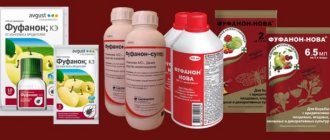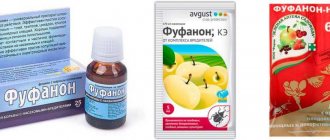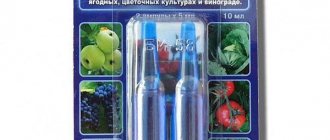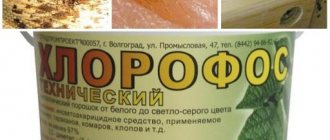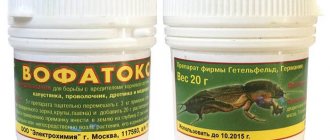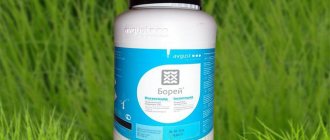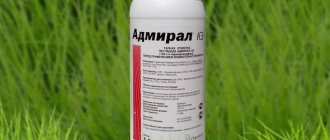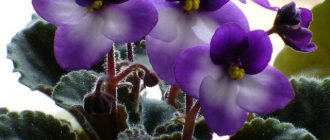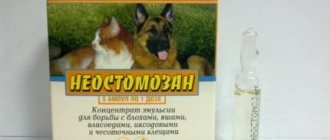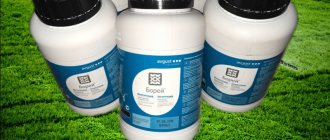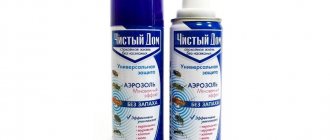Fufanon is one of the most effective insect repellents. The drug itself is a broad-spectrum organophosphorus insecticide. Fufanon has a fumigant, contact and intestinal spectrum of action for the extermination of insects of various species. The drug has a third level of toxicity for people and animals, so it can be used even in residential areas.
Scope of application of the insecticide
Fufanon can be combined with similar drugs (except Bordeaux mixture), but it is best not to experiment. The versatility of this product is used to combat the following pests:
- aphid;
- mites;
- thrips;
- mole;
- moths;
- gall midges;
- slowpoke;
- scale insects;
- sawfly;
- whitefish;
- weevil;
- leaf roller;
- whitefly;
- codling moth;
- raspberry beetle.
The main component of the drug is malathion (karbofos, cytion, adithiophosphate). Spraying can only be done if the plant has been attacked by insects . Once in the intestines of the pest, Fufanon affects its nervous system, causing rapid death.
Garden crops are most often attacked by various insects, which is why they need timely treatment:
- grape;
- apple trees;
- pears;
- gooseberry;
- strawberry;
- currant;
- cherries;
- quince;
- cherry;
- plum.
Active substance
Fufanon-Nova is an aqueous emulsion of malathion, an oily chemical from the group of organic phosphorus compounds. Malathion was first synthesized in the mid-20th century.
Main toxic properties:
- Highly toxic to insects, even in low concentrations.
- Low toxicity for mammals and humans in similar dosages (hazard class 3). An average degree of harm to human health occurs only with close contact with large volumes of concentrated substances.
- Mortal danger to bees (class 1).
- Moderate harmful effect on ticks and scale insects.
- No effect on plant development (no phytotoxicity).
- Rapid decomposition under the influence of wind and/or water: in greenhouses in 5 - 7 days, in the open air in 10 days.
- Relative resistance to ultraviolet radiation, as well as temperatures in the range from zero to +50 degrees.
- Neutralization in an alkaline environment.
Malathion:
- quickly eliminated from the body of mammals (including humans);
- does not accumulate in animal and plant tissues;
- is not a carcinogen;
- destroyed during heat treatment of food.
More on the topic: Herbicides against weeds on strawberries
Main advantages of the drug
Numerous customer reviews confirm that Fufanon is distinguished by its effectiveness and affordability. Depending on their goals, consumers can purchase analogues of the drug: Fufanon-super, Fufanon-nova and Fufanon K.E. If we talk about Fufanon-super, then we can note the following advantages, which are confirmed even by specialists and gardeners with many years of experience:
- Long period of plant protection after careful treatment. On average, the effect lasts for 31 days.
- High activity.
- Low percentage of negative impact on humans and the environment.
- The active substance included in Fufanon has a unique fumigant effect.
Among the negative aspects, the only thing that can be noted is that it is undesirable to combine the drug with other insecticides. The group of exceptions includes only substances of the pyrethroid class .
Processing regulations
Let's consider the regulations for the use of Fufanon preparations (consumption rates, dosages, waiting periods, frequency of treatments) against pests based on the characteristics of use:
- in private household plots - personal subsidiary plots;
- in industrial agricultural production;
- to combat synanthropic insect pests.
Application in private household plots (personal subsidiary plots)
Examples of Fufanon CE preparations from various manufacturers
Treatment is carried out by spraying and/or irrigation. The working solution is prepared and used on the day of treatment. Spraying is carried out in the evening or morning in calm weather. The minimum waiting period is at least 3-6 hours.
| Application rate/dosage | Processed crop | Pest | Features of application | Waiting period | Frequency of treatments |
| 12-14ml./10l. water | Pome crops - apple, pear, quince, etc. | Aphids, codling moth , mite, apple flower beetle, weevil, leaf roller, copperhead, sawfly, scale insect, false scale insect | Spraying treatment during the growing season. Working fluid consumption – 2-5 l./tree (depending on age and variety) | 20 | 2-3 |
| 12ml/10l. | Currants and gooseberries | Moth, aphids , moths, gall midges, leaf rollers, sawflies, scale insects, false scale insects | Spraying, consumption 1-1.5 l/bush | 20 | 2 |
| 10-12ml/10l. water | Stone fruits - plum, cherry, sweet cherry, apricot | Codling moth , leaf beetle, aphid, moth, weevil, sawfly, cherry fly, silkworm, moth, scale insect | Spraying treatment during the growing season. Working fluid consumption – 2-5 l./tree (depending on age and variety) | 20 | 2 |
| 11.5-12/10l. water | Strawberries | Mite, sawfly, raspberry weevil | Double treatment (before and after flowering) by spraying. Working fluid consumption - 1.5 l./10 m2. | 20 | 2 |
| 13ml./10l. water | Vegetables - cabbage, tomato, cucumber | Mites, aphids, thrips, sprout flies, cabbage cutworms, whiteflies , whiteflies, moths, thrips, etc. | Spraying during the growing season, consumption -1l./10m2 | 20 | 2 |
| 13ml./10l. water | Grape | Mealybug, mite | Spraying treatment during the growing season. Working fluid consumption – 2-5 l./bush (depending on the age and size of the bush) | 20 | 1-2 |
| 13ml./10l. water | Decorative shrubs and flowers | Pest complex | Double spraying (before and after flowering), consumption -1.5-2l./10m2 | No | 2 |
If some crops and/or pests were not listed in this table, then the application rates, waiting times and frequency of treatments can be viewed in the following table by recalculating the corresponding indicators.
Examples of the drug "Fufanon Nova"
Application of "Fufanon" in industrial agricultural production
| Application rate/dosage | Processed crop | Pest | Features of application | Waiting period |
| 0,7-1,6 | Cereals - wheat, barley | Aphids, thrips, wheat thrips | Spraying treatment during the growing season. Working fluid consumption – 2-4 l/100m2 | 30 |
| 0,8-1,5 | Corn | Leafhoppers, leaf aphids | Spraying, consumption 2-4l/100m2 | 20 |
| 0,7-1,6 | Legumes - peas | Aphids, bean moth, pea weevils and codling moth | Spraying, consumption 2-4l/100m2 | 20 |
| 1,3-1,6 | Sugar beet | Leafhoppers, bugs, leafminers, flies and moths, beet aphids | Spraying, consumption 2-4l/100m2 | 20 |
| 1-1,3 | Pome crops - apple, pear, quince, etc. | Codling moths, leaf rollers, mites, aphids, sawflies, scale insects, false scale insects, weevils, copperheads, etc. | Spraying treatment during the growing season. Working fluid consumption – 6-15l/100m2 | 20 |
| 1,3 | Stone fruits - cherries, sweet cherries, plums, apricots | Sawfly, aphids, weevil, codling moth, cherry fly | Spraying during the growing season, consumption 8-12l/100m2 | 20 |
| 1-1,5 | Sea buckthorn | Aphids, gall mite, copperhead, etc. | Spraying, consumption 5-8l/100m2 | — |
| 1,3-2 | Currants, gooseberries | Sawflies, scale insects, false scale insects, aphids, moths, gall midges, leaf rollers, moth | Spraying, consumption 8-12l/100m2 | 20 |
| 1,3-3,4 | Raspberries | Mites, aphids, raspberry-strawberry weevil, raspberry bud moth | Spraying before flowering and after harvesting, consumption 8-15l/100m2 | — |
| 1-1,2 | Strawberries, garden strawberries | Sawfly, whitefly, weevil, strawberry mite | Spraying, consumption 3-5l/100m2 | 20 |
| 1,3 | Grape | Mealybug, mites | Spraying during the growing season, consumption 8-12l/100m2 | 20 |
| 1 | Decorative garden shrubs | Aphids, mites, moths, leaf rollers, copperheads, etc. | Spraying, consumption 10-15l/100m2 | — |
| 0,8-1,6 | Cabbage | Whitefly, cabbage cutworms, whitefly, moths, aphids, thrips | Spraying, consumption 3-4l/100m2 | 20 |
| 0,8-1 | Rapeseed, sunflower | Cruciferous blight, rapeseed sawfly, bugs, leaf beetles, aphids | Spraying, consumption 2-3l/100m2 | 30-40 |
| 1,5 | Soybeans | Leaf beetles, mites, aphids, cutworms | Spraying, consumption 2-4l/100m2 | 30 |
| 0,8-1,6 | Open ground cucumber | Whitefly, mites, sprout flies, aphids, thrips, | Spraying during the growing season, consumption 2-4l/100m2 | 20 |
| 1,5-4,5 | Cucumber in greenhouses | Whitefly, mites, thrips | Spraying during the growing season, consumption 10-30l/100m2 | 1-3 |
| 0,8-1,6 | Open ground tomato | Whitefly, aphids, mites | Spraying during the growing season, consumption 2-4l/100m2 | 20 |
| 1,5-4,5 | Tomato in greenhouses | Whitefly, nightshade fly, thrips, mites | Spraying during the growing season, consumption 10-30l/100m2 | 1-3 |
Control of synanthropic insect pests (for the drug “Fufanon Super”)
The drug "Fufanon Super" to combat synanthropic insects
| Pest | Application rate/dosage | Consumption rate | Features of application | Frequency of treatments |
| Cockroaches | 10-20ml/1l of water | 100ml./1m2 | Treat thresholds, cracks, baseboards, along pipes and other habitats of cockroaches, as well as behind furniture, under the sink and bathtub. | 1-2 |
| flies | 10ml./1l.water | 500ml/1m2 | They treat garbage bins, livestock premises, and spray the product on the walls. Cesspools and yard toilets are also treated. | 1 |
| Fleas | 3.5-5ml/1l.water | 100ml./1m2 | The treatment is carried out by spraying the working solution onto the walls, floor, and along the baseboards. | 1-2 |
| Bed bugs | 3.5ml/1l.water | 100-200ml./1m2 | Apply the drug in habitats and concentrations of insects. Bedding cannot be processed. | 1-2 |
| Mosquitoes | 5-10ml/1l.water | 50-100ml./1m2 | Treatment is carried out by irrigation; when used indoors, after treatment, ventilate well after 2-3 hours. To destroy the larvae, the concentration is increased 3 times. | 1 |
| Red house ants | 5-10ml/1l.water | 100ml./1m2 | Treat areas where ants gather and move around | 1-2 |
Preparation of working solution
Fufanon's instructions indicate that to achieve the best results, the drug must be used in strict accordance with the instructions. The standard formula for preparing the solution is to dilute 10 ml of insecticide in 10 liters of plain water. You must first prepare a concentrated solution. To do this, you need to mix the drug with a small amount of water, and only then this concentrate is diluted into a working solution. As a result, you should get a cloudy white liquid, a little thick. The finished solution is poured into a spray bottle taking all precautions.
How to store
To store the insecticide indoors, select a dry, ventilated place inaccessible to children and pets. It is prohibited to store animal feed, drinking water, or food in the room.
The shelf life of the pesticide is 2 years from the date of manufacture. It is not recommended to store unused working solution (it must be disposed of according to the rules).
Spraying of garden crops
The instructions for use of Fufanon-nova and reviews about it say that it fights well against codling moths, flies, ticks, moths and aphids. It can also be used against other pests. Today, there are several options for using this drug for treating crops in open and closed ground. For example, cucumbers that grow indoors are processed only once, but tomatoes are processed no more than three times. For open ground, it is not recommended to carry out more than two sprayings. The first harvest is harvested no earlier than 20 days after treatment.
Mechanism of action
The drug belongs to organophosphorus compounds. Thanks to the active substance, when treating premises, pests lose their ability to move after 1.5-2 hours. After spraying, the insects die within 24 hours.
However, it must be taken into account that regular use of the drug contributes to the emergence of populations of insects and pests that are resistant to the action of malathion. Insects develop the physiological ability to destroy the active substance into products that are non-toxic to the body.
Treatment of premises with Fufanon
The instructions for use indicate that this product is most effective in combating bed bugs and pests of house plants. But today this insecticide is actively used for other purposes.
Reliable protection for indoor plants
Indoor plants are also vulnerable to insects, which often attack garden crops. Thanks to this, the drug Fufanon-nova is actively used at home. The final spraying efficiency is very high. Within a few days, absolutely all the pests that previously destroyed the plant disappear. In addition, some buyers noted that after treatment with this product, the plant sprouted new shoots , and the leaves became more lush and juicy.
Fighting bed bugs
Fufanon-super is used to combat bedbugs. The instructions for use and reviews indicate that the drug is affordable and highly effective. After all, those who have already encountered these insects will forever remember the unpleasant sensations from their bites.
Types of drug, dosage form and composition
“Fufanon” is an insectoacaricide, according to its chemical class it belongs to the FOS group of pesticides (organophosphorus compounds). According to the method of penetration, it is classified as a contact-intestinal pesticide.
The composition of the drug is the active substance (AI) malathion (440-570 g/l), surfactant (surfactant), solvent, stabilizer, thickener, buffer solution and inert filler up to 100%.
Currently, the drug is available in 4 versions, different in scope:
1. “Fufanon, CE” (emulsion concentrate), dosage DV 570g/l. Used in private household plots, agricultural production and on grains, legumes and other industrial crops. Process grain and vegetable storage facilities. It has a “smelly” distinct odor. Release form: 5 ml ampoules, 25 ml bottles, 5.0 l canister.
2. “Fufanon-Nova, VE” (water emulsion), DV dosage 440 g/l. A product for controlling agricultural pests in private household plots and small farms. Release form: 2 ml ampoules. and 6 ml., 0.5 l bottles.
3. “Fufanon-Super, VE” , malathion dosage 440 g/l. The drug is used primarily to combat synatropic insects. Release form: 5 ml ampoules and 0.2-1.0 l bottles.
4. “Fufanon Expert, VE” (new) - DV dosage 440 g/l. An effective insectoacaricide for the control of gnawing and sucking pests of agricultural crops in industrial agriculture.
Possible health hazard
Although fufanon is low-hazard for humans, ignoring the precautions specified in the instructions for the drug can lead to poisoning by insecticide vapors, with the following symptoms:
- dizziness;
- salivation;
- stomach ache;
- constriction of the pupil;
- nausea and vomiting;
- respiratory irritation;
- unpleasant taste in the mouth.
The first thing to do is to go outside, take off clothes soaked in the chemical and rinse your mouth with water. In case of severe poisoning, immediately call an ambulance. If it gets into your eyes, rinse them thoroughly several times with cold water and consult a doctor.
Step-by-step instructions for use
In order for the product to give the expected result, you must strictly follow the instructions on the packaging. It is prohibited to start working with the insecticide without studying this information. Neglecting protective measures can cause deterioration in health.
The main symptoms of poisoning are a sudden loss of strength, nausea, vomiting and severe dizziness. In such a situation, you need to go out into the fresh air, take a sorbent, and wait for the doctor to arrive. To avoid negative consequences, carefully prepare for the liquidation operation.
Preparatory activities
The first thing you have to do in the list of preparatory activities is the so-called “reconnaissance in force.” It’s good if you know exactly where bedbugs accumulate. To do this, move all cabinet and upholstered furniture away from the walls, check the most inaccessible places for the presence of chitinous shells and waste products of these disgusting insects. It is impossible not to notice the nest: it gives the impression of a lichen, unkempt place that you don’t want to touch, which is unpleasant to be near.
Safety precautions
At the second stage, the step before disinfestation, you should take care of your safety. The following attributes will help you with this:
Pets and household members must leave the family nest before disinfestation begins. Indoor flowers also need to be taken out. If there is a terrarium or aquarium in the house, the surface of the vessel must be covered with thick cardboard or a wooden barrier so that the chemical does not penetrate into the water.
Solution preparation and processing
To dilute the drug, take any container that has a non-food purpose and follow the instructions presented in table form.
Table - How to breed "Fufanon"
| Pests | Quantity of insecticide, ml | Quantity of water, ml | Consumption of the finished solution, ml/m2 |
| — Bugs; - ants; - fleas | From 1.5 to 3.5 | 1000 | 50 |
| — Flies; - cockroaches | — 9; — 11 | 1000 | 100 |
The chemical, packaged in ampoules, is diluted differently. To do this, one 5 ml ampoule is poured into a large container, and 5 liters of water are added there. Some sources indicate that the finished solution can be applied using a wide paint brush. However, spraying the drug using a sprayer or spray bottle is considered the most comfortable. When disinsection, the following recommendations should be followed.
Chemical structure and action
Chemically, karbofos is an ester of dithiophosphoric acid, i.e. it contains active sulfur. This is due to the increased activity of the drug at temperatures above +25 degrees Celsius.
The structural formula of karbofos (malathion) and its spatial model are shown on the left in Fig. Pure malathion is a colorless oily liquid with a nasty odor that sticks to a certain surface better than sunflower oil and makes it non-wettable. This is why malathion initially found application in ore flotation.
Chemical formula and scheme of action of karbofos
Pure malathion is not very toxic and is easily neutralized by weak alkalis (eg, soda ash solution). But its solubility in water (145 mg/l) is sufficient to obtain a pronounced contact effect on pests, and good solubility in organic solvents enhances the penetration of the substance into the body of gnawing and sucking insects. When they feed, they are inevitably smeared with plant juice, and it always contains aldehydes, alcohols, ketones and other substances in which malathion dissolves well.
In the pest's body, malathion is firstly broken down according to the diagram at the top right in Fig. for very toxic esters of thiosuccinic and fumaric acids and the salt of dimethylthiophosphoric acid. The protective and digestive enzymes of the target in this case do him a disservice. It is difficult to obtain these poisons in the laboratory; they are very dangerous for all animals and quickly disintegrate in air. And so – the pest prepares a deadly poison for itself from moderately toxic raw materials.
Secondly, if the pest is an insect, in its body under certain conditions a specific reaction of malathion hydrolysis occurs according to the diagram at the bottom right in Fig. Its product, malaoxon, is an even stronger and more persistent poison for insects. This explains the different periods of protective action of Fufanon in different cases: on ticks in the open air for 5 days, on insects in the same place for 7 days, and in rooms where the lighting is weak and daily temperature fluctuations are small, up to 21 days.
Three ends of one stick
Malaoxone is not only a poison for insects, but also a mutagen. Among the surviving mutants, they are resistant to both malathion and all OPCs. In this case, it is possible to eliminate the resistant population 100% only by leaving the land fallow for 2-3 years and using preventive treatments with pesticides on a different chemical basis: carbamates, pyrethroids, neonicotinoids.
Until recently, it was believed that the breakdown products of karbofos in warm-blooded animals were slightly toxic and did not damage their DNA. But in recent years it has been discovered that under certain conditions, both a certain amount of malaoxone and dithiophosphate, which is highly toxic to vertebrates, are formed.
The conclusion from here is trivial for all pesticides: do not exceed dosages and do not experiment on your own with the regulations for use!
Fufanon CE and Nova: purpose and effectiveness
“Fufanon-KE” and “Fufanon-nova” have a contact, intestinal and fumigant effect, which allows the product to be used for treating fruit trees, berry bushes, vegetable and flower crops, as well as indoor plants. The active substance is malathion, at a concentration of 570 g/kg.
The concentrated emulsion is a clear yellowish liquid and is available in 5.0 ml ampoules and 10.0 ml bottles. The product is used to protect gardening, flowering and decorative deciduous garden and indoor crops from plant parasites, represented by:
- weevils;
- codling moths;
- ticks;
- black and green aphids;
- thrips;
- leaf rollers;
- flies;
- whiteflies;
- raspberry beetles;
- whitewash;
- copperhead;
- sawflies;
- scale insects and false scale insects;
- scoops;
- gall midges;
- mealybugs;
- fire;
- moth
The “Fufanon” and “Fufanon-Nova” products have retained their high efficiency, but the difference from the previous generation products is an expanded spectrum of effects, a convenient release form in the form of plastic ampoules, and safety for humans and animals.
Fufanon for bedbugs price in 2022
| Name | Volume, ml | Price, rubles |
| Fufanon-Nova | ||
| 2 ml | 12-15 rubles | |
| 6.5 ml | 20-30 rubles | |
| 10 ml | 35-50 rubles | |
| Fufanon Super | ||
| 1000 ml | 1200-1500 rubles | |
| Fufanon | ||
| 5 ml | 10-15 rubles | |
| 25 ml | 40-60 rubles | |
| 50 ml | 100-150 rubles | |
| 100 ml | 250-300 rubles | |
| 5000 ml | 4500-5500 rubles |
Compatibility with other drugs
When creating a composition, you can pour different pesticides, as well as growth stimulants, into one tank.
You can add Fufanon-nova to:
- “Kurzat-R” is a fungicide, it is used if plants are affected by fungi and bacteria, and also for the prevention of these diseases;
- “Preparation No. 30”, which protects the area from pests that have overwintered in the roots;
- Colloidal sulfur, it treats plants from powdery mildew, very often cucumbers and grape bushes begin to suffer from this;
- “Zircon” - it stimulates the development of the root system and fruit ripening;
- "Epin" - strengthens the immunity of crops.
Kurzat
Preparation No. 30
Colloidal sulfur
Zircon
Epin
Procedure for removing parasites
In the vast majority of cases, SES workers remove bedbugs in one sanitary treatment. But even before this procedure is carried out, a specialist goes to the site - a city apartment, a residential building, a cottage community - to clarify the situation on the spot.
Often, during such an inspection, the residents of the premises learn a lot of new things not only about the number of bedbugs in their apartment, but also about the situation with them among their neighbors. In addition, the visiting inspector of the Sanitary and Epidemiological Station always has extensive experience in exterminating not only bedbugs, but also other insects, and knows very well where to look for them, in which places the main populations are kept, and how to find bedbugs in places where it is difficult to even look.
In many cases, after inspecting the premises, the SES specialist orders that neighboring apartments be examined and treated. This is especially true for apartment buildings: here, the first to raise the alarm may be the residents of apartments that are not the most infested, while, perhaps, their neighbors live next door to a real bedbug infestation.
See also our experiments on bedbugs:
We catch bedbugs and test different products against them - see the results...
- We test the effect of Hector powder on bedbugs in two options: simple treatment and preparation of traps. See the results of the experiment. An experiment on bedbugs: at what temperature do they die and how can this be used in practice? We put the bedbugs in a container that was treated with the Executioner product a week ago - we’ll see if the parasites are poisoned by the long-dried product...
- We tested the Get Express product on bedbugs - let's see what came of it... Experiment on bedbugs: The Executioner killed them in 8 minutes
We check the residual effect of the Executioner on bedbugs (how quickly they are poisoned upon contact with a previously treated, but already dried surface) - Proven methods of killing bedbugs that have shown to be highly effective
In some cases, the Sanitary and Epidemiological Station inspector makes such visits to inspect the premises several times - to assess the increase in the number of parasites and their possible spread.
Before sanitizing the premises, an agreement is signed between the customer and the SES to carry out pest control work. Based on the concluded agreement, the SES already prescribes treatment for bedbugs.
Wherein:
- At the Sanitary and Epidemiological Station, tactics are being developed for the destruction of bedbugs and other insects, depending on their species composition and number. To the credit of the SES, it should be noted that many other pest control companies almost never carry out such work.
- A means to kill bedbugs is selected.
- Actual measures to exterminate insects are being carried out.
- Subsequently, a representative of the SES monitors the effectiveness of the sanitation performed.
It is usually considered that sanitation against bedbugs is effective if bedbugs have not appeared in the room within two months after it has been carried out.
Sanitation for bedbugs is carried out in a room from which all residents and pets have been removed. In this case, all accessible surfaces, contaminated furniture and clothing are treated. After the work is completed, the responsible specialist draws up an acceptance certificate for the work performed, which indicates the area of the treated premises, as well as the quantity and type of insecticidal agent used.
To treat an infected area, you need to use a stronger concentration. In this case, dilute one ampoule in 5 liters of water. To treat hard-to-reach places where parasites most often live, you can prepare a powerful solution. To do this, mix 5 ml of Fufanon per 1 liter of water. This is a dangerous composition that should only be used by a specialist.
- If the product touches the skin of the face or eyes, immediately rinse the area with clean water. It is best to consult a doctor after this to avoid side effects.
- You need to leave the apartment for a day after treatment.
- When processing, you need to ventilate the room so as not to be poisoned by the chemical composition.
- After the procedure, you need to thoroughly wash your body.
Remember that all insects will die only after 3-4 days. The product will act on both adult bedbugs and bedbug larvae. If the room is heavily infested with insects, treat it several times to eradicate all the bugs in the apartment.
